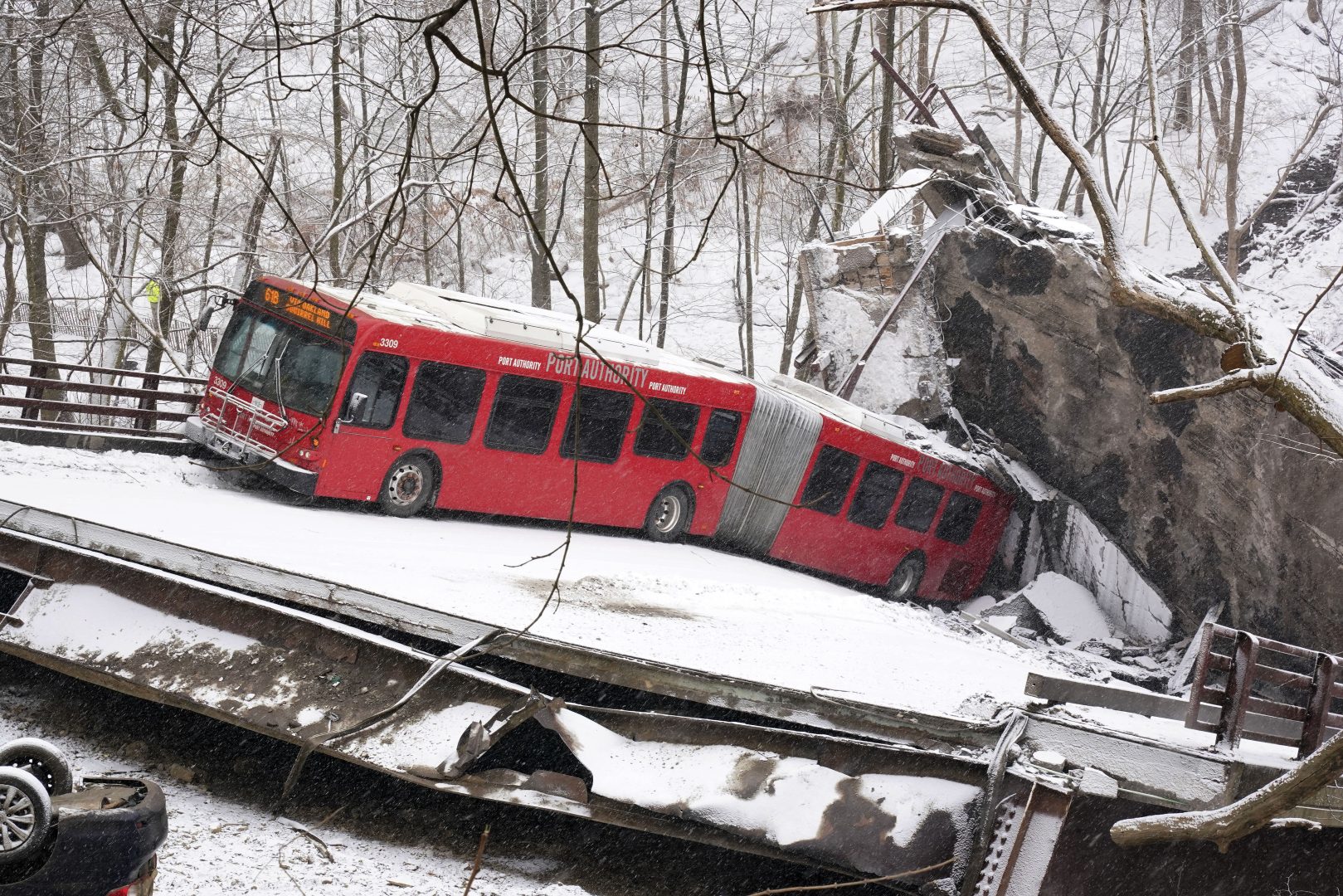
This is a Pittsburgh Transit Authority bus that was on the Fern Hollow Bridge in Pittsburgh when it collapsed Friday morning Friday, Jan. 28, 2022. (AP Photo/Gene J. Puskar)
Gene J. Puskar / AP

This is a Pittsburgh Transit Authority bus that was on the Fern Hollow Bridge in Pittsburgh when it collapsed Friday morning Friday, Jan. 28, 2022. (AP Photo/Gene J. Puskar)
Gene J. Puskar / AP

Gene J. Puskar / AP
This is a Pittsburgh Transit Authority bus that was on the Fern Hollow Bridge in Pittsburgh when it collapsed Friday morning Friday, Jan. 28, 2022. (AP Photo/Gene J. Puskar)
The 2022 collapse of the Fern Hollow Bridge resulted from “extensive corrosion” and officials’ repeated inaction in the face of maintenance and repair recommendations, the National Transportation Safety Board said Wednesday.
The agency said the City of Pittsburgh, Pennsylvania Department of Transportation and Federal Highway Administration provided “insufficient oversight” of the structure.
“On behalf of the NTSB, we are so sorry you experienced such a terrifying event,” said board chair Jennifer Homendy during a meeting in which the board heard the results of an investigation into the collapse. “The Fern Hollow Bridge collapse should never have happened.”
She later added that the bridge was in such poor condition, it should have been closed to traffic before the collapse could take place. “There were a lot of failures here.”
An NTSB investigation found that the bridge’s design, and the materials used to build it, were not factors in the collapse. Had the structure been properly maintained, the bridge could have been expected to last for “many more years,” said Office of Highways Safety senior structural engineer Steve Prouty.
Prouty said that other bridges with the same design and built from similar materials that have been properly maintained are in “very good condition,” and were expected to remain functional “for many decades to come.”
As the owner of the bridge, the city was responsible for maintenance, but failed to act on multiple inspection reports that, over the course of 16 years, warned of worsening corrosion and section loss. Pittsburgh did not “sufficiently comply with inspections,” investigators said.
Record-keeping was so inadequate that the city did not know how much additional paving had been done on the road. An incorrect number was used in 2014 to calculate a bridge weight limit of 26 tons — nearly four times higher than engineers later said it should have been.
Inspections by third-party contractors repeatedly showed clogged drains, which allowed water and salts to accumulate on the bridge supports, preventing them from drying and a protective patina from forming on the uncoated weathering steel. That led to severe corrosion that ultimately allowed the collapse to occur.
By September 2021, when the bridge was last inspected, there were 12 inch by 12 inch holes in the legs. The city was ordered to fix them before the next inspection, which was slated for 2023. By that point, the bridge had already collapsed.
At the time, PennDOT’s Bridge Conditions page deemed the bridge’s substructure “satisfactory” with some minor deterioration. The deck and superstructure received “poor” ratings, and it was noted that deterioration of central elements “has advanced.”
Though inspectors told the city that the bridge’s cross-bracing needed to be replaced, it never was. Similarly, a corrosion-preventing coating was never applied.
Pittsburgh Mayor Ed Gainey addressed the report briefly at an unrelated press gathering where he called the collapse “the most scariest day of my life.”
Gainey said he and his staff needed more time to digest the report, but he said his administration had been “proactive,” in developing programs to review the conditions of other bridges. And he noted that the collapse happened just weeks into his tenure.
“We inherited a lot,” he said.
The bridge, a vital connection between Squirrel Hill and Regent Square, collapsed around 6:39 a.m. on Jan. 28, 2022. Prior to the collapse, it carried more than 14,000 cars daily.
Four cars and a Pittsburgh Regional Transit bus were on the bridge when it began to crumble and fell into Frick Park below. Nine people were in the vehicles; several of them were injured.
“This bridge didn’t collapse just by an act of God,” said board member Michael Graham. “It collapsed because of a lack of maintenance and repair. And that’s just sad for the city.”
The board’s three sitting members (there are currently two unfilled seats) voted unanimously to adopt the proposed findings and probable cause. The Federal Highway Administration, PennDOT and city of Pittsburgh were all given recommendations to prevent future collapses. PennDOT has been asked to evaluate the effectiveness of changes made by Pittsburgh officials in response to the findings, and to track and monitor progress on bridge maintenance and repair recommendations to ensure they’re completed.
In her closing statement, Homendy quoted author Kurt Vonnegut.
“‘Everybody wants to build and nobody wants to do maintenance,’” she said. “The Fern Hollow catastrophe was a serious wake-up call for both the city of Pittsburgh and PennDOT. I hope it serves as a wake-up call for every other bridge owner in the state.”
“We cannot take our infrastructure for granted,” she continued. “Lives depend on it.”
NTSB’s final report will be posted online in the coming weeks.

Sometimes, your mornings are just too busy to catch the news beyond a headline or two. Don’t worry. The Morning Agenda has got your back. Each weekday morning, host Tim Lambert will keep you informed, amused, enlightened and up-to-date on what’s happening in central Pennsylvania and the rest of this great commonwealth.
The days of journalism’s one-way street of simply producing stories for the public have long been over. Now, it’s time to find better ways to interact with you and ensure we meet your high standards of what a credible media organization should be.